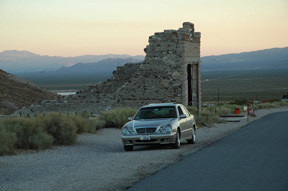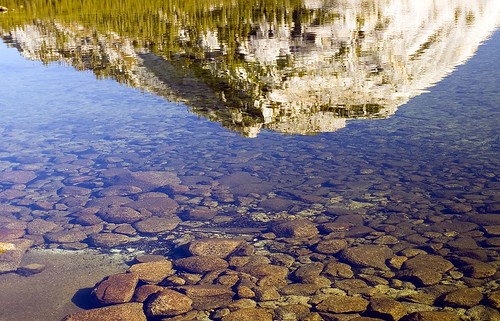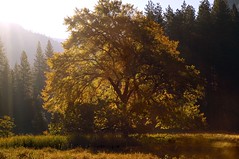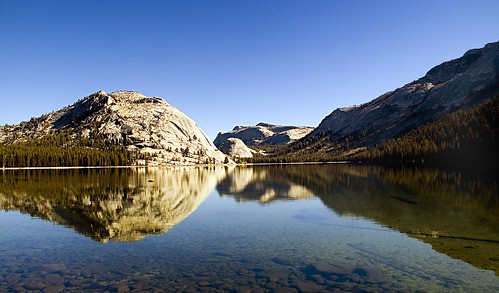Leaving the waterfalls of Yosemite behind, I continued with my trip.
The sun was just reaching the trees, as in this picture, when I drove through the Valley on my way to the junction with Route 120 towards Tioga Pass. (You can see a map here.)
At the opening to the Valley, where Route 120 peels up and away from Route 140 (which heads down to Merced), I saw a hitchhiker with a backpack headed my way. It’s perhaps appropriate to mention at this point that the car I drive, fondly called “URL” (his license plate — we pronounce it “earl”), was bought with tech bubble proceeds to impress investors, and not as a photographer’s car. Here’s a picture of URL-the-car (taken later on this same trip in Rhyolite-the-ghost-town):

To digress, “URL” is a great car for roadtrips, but not really the thing for navigating tracks in the mountains and deserts (let alone the trackless mountains and desert) . The ideal photographer’s car should be four-wheel drive, have high clearance, not be conspicuous, and have room to sleep in the back.
The hitchhiker was about my age (definitely old enough to know better) as scruffy as only someone can be who has been spending unwashed time on the trail. His name was Mark. Mark smelled bad enough that I inwardly winced when he said he was going up to Lake Tenaya — when I smelled the stink I’d been hoping the ride would be of shorter duration. I powered down my window even though it was morning chill outside.
Things got better when we started talking. Mark was from Idaho. He’d left his car up at the Sunrise lot near Lake Tenaya, and hiked down to the Valley. After several days, he was on his way back to his car.
Mark explained to me that he wasn’t carrying any food to avoid having to deal with bear canisters (and the bears in the Valley). I stopped by Yosemite Creek at a picnic ground to get him some jerky and trail mix. Mark said he could eat as we drove. I explained to him that nobody eats in URL-the-car, and asked him to finish eating before we started driving again. I think Mark thought this was pretty funny — he started asking about my kids, the state of my wife’s car, and how I felt about desert dust.
I asked Mark what he did for a living, and he said he was an investor. Pretty soon we were deep in arcane discussions of Brazilian index funds, energy options, and technology stocks.
Mark said he thought people in their twenties were different from him and me. I asked how, specifically. He said they didn’t have a clue about vaccuum cleaners. (Meaning, I guess, that cleaning wasn’t high on the agenda for young people, and also that they found it hard to follow the linear instruction materials that typically come with appliances like vaccuum cleaners.)
I asked Mark why he thought he knew about twenty-somethings. He said he winters in the south of India, spending $1.23 a day, and spends a lot of time with young people on the beach in India and at Burning Man.
I think Mark was missing what the social scientists call an intervening variable: the people who end up on the beach in Southern India, or at Burning Man, of whatever age, are less likely to be interested in vaccuum cleaners than people walking the corporate path. When I was much younger, I had a girlfriend I thought very exotic and intriguing because she had spent a great deal of time hanging out in India. She was inordinately fond of her bong from Goa. And she certainly didn’t have a clue about vaccuum cleaners, or cleanliness. QED.
But Mark was truly right about one thing that is usually very hard for wealthy people to grasp. He said, “I think having too much money can really isolate you from important life experiences.”
For example, most millionaires don’t hitchhike. If Mark were one of them, he and I wouldn’t have met, and I would have missed getting to know a fascinating soul.
It’s hard for me to remember all of our wide-ranging conversation, but I do think that the most important for Mark was that people should avoid being trapped by their habits, and avoid getting stuck in a narrow rut. In his view, having money is a potential trap — as is simply following habits reflexively. He said, “If you are getting stuck doing the same thing without thinking, move to another city.”
I dropped Mark off at his car (a battered camper with Idaho plates) and stopped beside Lake Tenaya to photograph the reflections shown at the top of this story, in a previous blog story, and here:



Pingback: Photoblog 2.0: » Photoblog 2.0 Archive: » Road Trip Wrap-Up